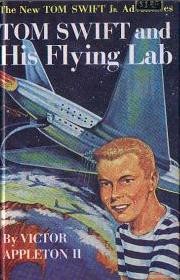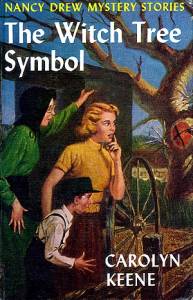Rodney Elkins, Tony Sandow, David Twedell, Jeff Seacrest, Mickey Williamson, Sammy Ritter, David Posey, Jimmy Allen, Randy Patrick and Barry Payne were some of my male classmates in third and fourth grades at Edwin J. Kiest Elementary School in Dallas. The years were 1962 and 1963. It seems that we all had a passion for reading Tom Swift books. Tom, a preternaturally bright and courageous teenage boy, was the main character in this popular series in the genre of juvenile science fiction. If I may simplify, there were two series: 1910 to 1941 and 1954 to 1971. A few of the titles were Tom Swift and His Submarine Boat, Tom Swift and His Photo Telephone, Tom Swift and His Giant Telescope, Tom Swift in the Caves of Nuclear Fire, Tom Swift and His Triphibian Atomcar, Tom Swift and the Mystery Comet, Tom Swift and His Diving Seacopter (my favorite) and Tom Swift in the Race to the Moon.
two series: 1910 to 1941 and 1954 to 1971. A few of the titles were Tom Swift and His Submarine Boat, Tom Swift and His Photo Telephone, Tom Swift and His Giant Telescope, Tom Swift in the Caves of Nuclear Fire, Tom Swift and His Triphibian Atomcar, Tom Swift and the Mystery Comet, Tom Swift and His Diving Seacopter (my favorite) and Tom Swift in the Race to the Moon.
Assembly-line literature
More than 30 million Tom Swift books have been sold, and many titles are still in print. The author of the books we read, in the second series, was Victor Appleton II, but that was a pseudonym. In fact, a number of ghostwriters crafted these tales under the careful guidance of Harriet Stratemeyer, whose father had founded the Stratemeyer Syndicate in the early 20th century.
Needless to say, Tom, a resident of the fictional Shopton, New York, invented one amazing contraption after another and used them in fighting evil, saving the world and so on. OK, I admit, it was a bit formulaic. Tom and his good-humored sidekick, Bud Barclay (whose GF was Tom’s sister, Sandy), were too virtuous to be believed. The plots were often quite incongruous. Come on, now—by what means was Tom able to conceive and invent such elaborate gizmos in his workshop? He and Bud casually traveled to distant outer space, to the depths of the oceans and to the center of the earth. Somehow, it seemed plausible. Us Kiest boys in the early 1960s loved these stories.
But, Tom, what about IP?
I would be remiss if I failed to ask why Tom was not in close contact with an intellectual property attorney. Had he patented his “electric runabout,” his “aerial warship,” his “ultrasonic cycloplane” or his “repelatron skyway,” he would have enriched himself and his descendants greatly. These, after all, were inventions of staggering profundity. Maybe it’s because some of Tom’s gadgetry relied on mysterious or cosmic forces. It would be hard to convince one of the USPTO‘s examiners of that.
Fiction, of course, requires the reader to suspend disbelief or skeptical attitudes. At age 10, I was willing to do it. While I am still an avid reader, fiction today is almost completely absent from my library. Give me facts and reality, not dreams and fantasy that spring out of somebody’s head. A few years ago, I read Don Quixote and enjoyed it, but Cervantes’ classic has proven value and has stood the test of time. Science fiction? I view it with disdain, if not contempt. Oh, these fools who immerse themselves in Star Trek!
Nevertheless, such unquestionably smart people as Steve Wozniak and Isaac Asimov have cited the Tom Swift series as an inspiration. And some of Tom’s creations may have led to inventions in the real world. The most famous example comes from Tom Swift and His Electric Rifle, published in 1911. It drove the creation of the taser, according to inventor Jack Cover: “taser = Thomas A. Swift Electric Rifle.”
Too many adverbs
The Tom Swift books, printed over a six-decade span, have had a degree of cultural influence. They assisted the growth of American science fiction and other forms of literature that focused on brilliant scientists and inventors. Young imaginations were sparked, and that can never be gainsaid. There is a Tom Swift discussion group and a Tom Swift web site, if you are interested. Some people are quite nostalgic about these books. But the series’ writing style has been lampooned, most of all its overuse of adverbs. Plans for movies, and TV and radio shows never got off the ground. Even though changes were made, the series was hopelessly dated. As a proud European-American, I am not inclined to abjure my  heritage. Still, Tom Swift was pretty white-bread and could have used some Afro-Caribbean syncopation or other forms of “diversity,” if you will. What post-modern fiction writer would choose to give his main character blond hair?
heritage. Still, Tom Swift was pretty white-bread and could have used some Afro-Caribbean syncopation or other forms of “diversity,” if you will. What post-modern fiction writer would choose to give his main character blond hair?
I mentioned how Rodney, Tony, David et al. devoured these books 50-plus years ago. But what about the girls in our class? The only names I can recall from 3B and 4B at Kiest are Vicki Box, Nancy Stein and Laura Brice; the genders self-segregated, although that would soon change. Female students had their own favorite, the Nancy Drew series. Nancy, a teenage detective—again, suspension of disbelief—solved all sorts of mysteries and was no less wholesome than our Tom. Please note that in a book published in 1930, she was using a cell phone and driving a hybrid electric vehicle. Nancy Drew, a feminist icon of sorts, has been the subject of some high-brow analysis. Sandra Day O’Connor, Sonia Sotomayor, Hillary Clinton and Laura Bush have acknowledged her as a heroine from their respective girlhoods.

Add Comment